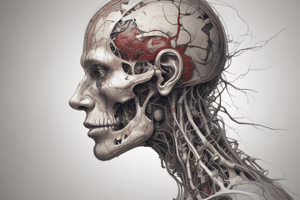Podcast
Questions and Answers
Cushing triad in a patient is a sign of which of the following?
Cushing triad in a patient is a sign of which of the following?
- Hypotension
- Hypoxia
- Intracranial pressure (correct)
- Dehydration
What numeric value should you assign to a patient with a head injury for abnormal flexion of his extremities?
What numeric value should you assign to a patient with a head injury for abnormal flexion of his extremities?
3
A tight-fitting motorcycle helmet should be left in place unless it interferes with your assessment of the airway.
A tight-fitting motorcycle helmet should be left in place unless it interferes with your assessment of the airway.
True (A)
An indicator of an expanding intracranial hematoma or rapidly progressing brain swelling is?
An indicator of an expanding intracranial hematoma or rapidly progressing brain swelling is?
Common signs and symptoms of a serious head injury include all of the following, EXCEPT:
Common signs and symptoms of a serious head injury include all of the following, EXCEPT:
What should you do for a 19-year-old unconscious male with severe head trauma who has bloody secretions draining from his mouth and nose?
What should you do for a 19-year-old unconscious male with severe head trauma who has bloody secretions draining from his mouth and nose?
Hyperextension injuries of the spine are MOST commonly the result of?
Hyperextension injuries of the spine are MOST commonly the result of?
In contrast to a cerebral concussion, a cerebral contusion involves physical injury to the brain tissue.
In contrast to a cerebral concussion, a cerebral contusion involves physical injury to the brain tissue.
Once a cervical collar has been applied to a patient with a possible spinal injury, it should not be removed unless it causes a problem managing the airway.
Once a cervical collar has been applied to a patient with a possible spinal injury, it should not be removed unless it causes a problem managing the airway.
The central nervous system (CNS) is composed of the?
The central nervous system (CNS) is composed of the?
The five sections of the spinal column, in descending order, are?
The five sections of the spinal column, in descending order, are?
The Glasgow Coma Scale (GCS) is used to assess?
The Glasgow Coma Scale (GCS) is used to assess?
What is the ideal procedure for moving an injured patient from the ground to a backboard?
What is the ideal procedure for moving an injured patient from the ground to a backboard?
What part of the nervous system controls the body's voluntary activities?
What part of the nervous system controls the body's voluntary activities?
When activated, the sympathetic nervous system produces all of the following effects, EXCEPT:
When activated, the sympathetic nervous system produces all of the following effects, EXCEPT:
When assessing a patient with a head injury, the presence of thin, bloody fluid draining from his right ear indicates?
When assessing a patient with a head injury, the presence of thin, bloody fluid draining from his right ear indicates?
Which breathing pattern is MOST indicative of increased intracranial pressure?
Which breathing pattern is MOST indicative of increased intracranial pressure?
Which of the following statements regarding secondary brain injury is correct?
Which of the following statements regarding secondary brain injury is correct?
You should be MOST suspicious that a patient has experienced a significant head injury if his or her pulse is?
You should be MOST suspicious that a patient has experienced a significant head injury if his or her pulse is?
Flashcards are hidden until you start studying
Study Notes
Head and Spine Injuries
-
Cushing Triad: A sign of increased intracranial pressure, characterized by hypertension, irregular respirations, and bradycardia.
-
Motor Response Assessment: An unconscious patient with abnormal extremity flexion is rated 3 on the motor response scale.
-
Helmet Protocol: A tight-fitting motorcycle helmet should remain in place unless it obstructs airway assessment.
-
Neurologic Deterioration: Rapid worsening of neurologic signs indicates an expanding intracranial hematoma or brain swelling.
-
Signs of Serious Head Injury: Common indicators include altered consciousness and potentially slow pulse. A rapid, thready pulse is NOT a typical sign.
-
Suctioning Protocol: For a patient with severe head trauma and respiratory distress, suction the oropharynx for a maximum of 15 seconds to clear secretions.
-
Spinal Injury Causes: Hyperextension injuries of the spine are most frequently associated with hangings.
-
Cerebral Contusion vs. Concussion: A contusion involves physical brain injury and is more severe than a concussion, which may not show structural damage.
-
Cervical Collar Application: A cervical collar should remain on unless it poses a problem for airway management.
-
CNS Composition: The central nervous system consists of the brain and spinal cord.
-
Spinal Column Sections: The spinal column is divided into five regions: cervical, thoracic, lumbar, sacral, and coccygeal, in descending order.
-
Glasgow Coma Scale (GCS): This scale assesses the level of consciousness based on eye opening, verbal response, and motor skills.
-
Patient Movement Technique: The optimal method for transferring a patient from the ground to a backboard is through the four-person log roll technique.
-
Somatic Nervous System: This component controls voluntary bodily functions and movements.
-
Sympathetic Nervous System Activation: It causes physiological responses such as increased heart rate and dilated pupils, but does NOT induce pupillary constriction.
-
Ear Fluid Leakage: Thin, bloody fluid leaking from the ear may signify a ruptured tympanic membrane due to head trauma.
-
Breathing Patterns: An irregular breathing pattern with variable rates and periods of apnea can indicate increased intracranial pressure.
-
Secondary Brain Injury Causes: The most common factors leading to secondary brain injury are hypoxia and hypotension.
-
Pulse Rate Indicator: A slow pulse in a head-injured patient raises suspicion of significant head trauma.
Studying That Suits You
Use AI to generate personalized quizzes and flashcards to suit your learning preferences.




